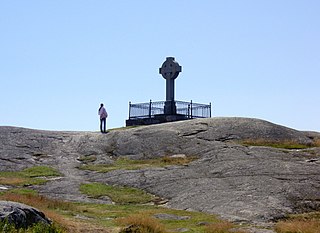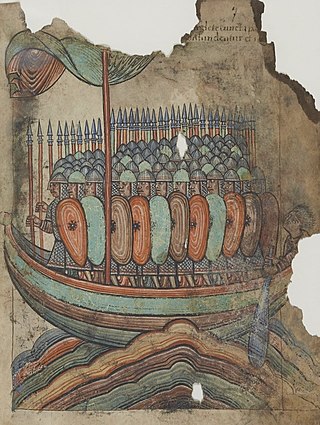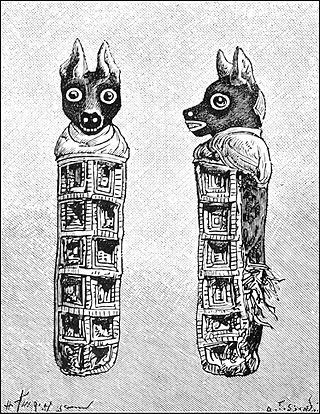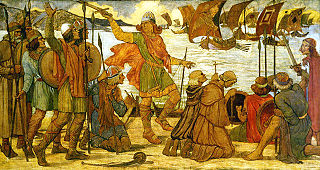
Birka, on the island of Björkö in present-day Sweden, was an important Viking Age trading center which handled goods from Scandinavia as well as many parts of the European continent and the Orient. Björkö is located in Lake Mälaren, 30 kilometers west of contemporary Stockholm, in the municipality of Ekerö.

Vikings were seafaring people originally from Scandinavia, who from the late 8th to the late 11th centuries raided, pirated, traded, and settled throughout parts of Europe. They also voyaged as far as the Mediterranean, North Africa, the Middle East, Greenland, and Vinland. In their countries of origin, and some of the countries they raided and settled in, this period is popularly known as the Viking Age, and the term "Viking" also commonly includes the inhabitants of the Scandinavian homelands as a whole. The Vikings had a profound impact on the early medieval history of Scandinavia, the British Isles, France, Estonia, and Kievan Rus'.

Zooarchaeology merges the disciplines of zoology and archaeology, focusing on the analysis of animal remains within archaeological sites. This field, managed by specialists known as zooarchaeologists or faunal analysts, examines remnants such as bones, shells, hair, chitin, scales, hides, and proteins, such as DNA, to derive insights into historical human-animal interactions and environmental conditions. While bones and shells tend to be relatively more preserved in archaeological contexts, the survival of faunal remains is generally infrequent. The degradation or fragmentation of faunal remains presents challenges in the accurate analysis and interpretation of data.
Osteology is the scientific study of bones, practised by osteologists. A subdiscipline of anatomy, anthropology, and paleontology, osteology is the detailed study of the structure of bones, skeletal elements, teeth, microbone morphology, function, disease, pathology, the process of ossification from cartilaginous molds, and the resistance and hardness of bones (biophysics).

A shield-maiden was a female warrior from Scandinavian folklore and mythology.

The Oseberg ship is a well-preserved Viking ship discovered in a large burial mound at the Oseberg farm near Tønsberg in Vestfold county, Norway. This ship is commonly acknowledged to be among the finest artifacts to have survived from the Viking Age. The ship and some of its contents are displayed at the Viking Ship Museum at Bygdøy on the western side of Oslo, Norway.

Knowledge about military technology of the Viking Age is based on relatively sparse archaeological finds, pictorial representations, and to some extent on the accounts in the Norse sagas and laws recorded in the 12th–14th century.
Below are notable events in archaeology that occurred in 1878.
Grobiņa is a town in South Kurzeme Municipality in the Courland region of Latvia, eleven kilometers east of Liepāja. It was founded by the Teutonic Knights in the 13th century. Some ruins of their Grobina castle are still visible. The town was given its charter in 1695.

The Windover Archeological Site is a Middle Archaic archaeological site and National Historic Landmark in Brevard County near Titusville, Florida, United States on the central east coast of the state. Windover is a muck pond where skeletal remains of 168 individuals were found buried in the peat at the bottom of the pond. The skeletons were well preserved because of the peat. In addition, remarkably well-preserved brain tissue has been recovered from 91 skulls from the site. DNA from the brain tissue has been sequenced. The collection of human skeletal remains and artifacts recovered from Windover Pond represent among the largest finds of each type from the Archaic Period. It is considered one of the most important archeological sites ever excavated.

Although the majority of pirates in history have been men, there are around a hundred known examples of female pirates, about forty of whom were active in the Golden Age of Piracy. Some women have been pirate captains and some have commanded entire pirate fleets. Among the most powerful pirate women were figures such as Zheng Yi Sao (1775–1844) and Huang Bamei (1906–1982), both of whom led tens of thousands of pirates.

Knut Hjalmar Stolpe, was a Swedish entomologist, archaeologist, and ethnographer. He was the first director and curator of the Museum of Ethnography, Sweden. He is best known for his meticulous archaeological excavations at the Viking-age site Birka on the island Björkö.
The Ridgeway Hill Viking burial pit at Ridgeway Hill near Weymouth, Dorset, was a mass grave of 54 skeletons, including 51 skulls, of Scandinavian men executed some time between AD 970 and 1025. The men are believed to have been Vikings executed by local Anglo-Saxons. The dismembered skeletons were discovered by archaeologists in June 2009, and their identity and approximate ages were later confirmed by forensic analyses. Although the immediate circumstances of the deaths is unknown, the event occurred at a time of conflict between the native Anglo-Saxons and Viking invaders, and it has been suggested that the Vikings had been captured during an attempted raid into Anglo-Saxon territory. There is a possibility it could be linked to the St. Brice's Day massacre order of 1002. It is suggested that the 'Oxford Massacre' was not an isolated incident and could have been part of a kingdom-wide order to eradicate the Vikings.
The Salme ships are two clinker-built ships of Scandinavian origin discovered in 2008 and 2010 near the village of Salme on the island of Saaremaa, Estonia. Both ships were used for ship burials here around AD 700–750 in the Nordic Iron Age and contained the remains of 41 warriors killed in battle, as well as 6 dogs, 2 hunting hawks and numerous weapons and other artifacts.

The remains of Richard III, the last English king killed in battle and last king of the House of York, were discovered within the site of the former Grey Friars Priory in Leicester, England, in September 2012. Following extensive anthropological and genetic testing, the remains were reinterred at Leicester Cathedral on 26 March 2015.
Björn Ambrosiani is a Swedish archaeologist and former civil servant. He worked at the Swedish History Museum and the Swedish National Heritage Board, as a research director among other positions.
The Griffin Warrior Tomb is a Bronze Age shaft tomb dating to around 1450 BC, near the ancient city of Pylos in Greece. The grave was discovered by a research team sponsored by the University of Cincinnati and led by husband-and-wife archaeologists Jack L. Davis and Sharon Stocker. The tomb site was excavated from May to October 2015.
Bodzia Cemetery is a large 10th – 11th century chamber burial site in Bodzia, a town in the Kuyavia region of Central Poland, approximately 15 km to the northwest of Włocławek. A group from the Polish Academy of Sciences, led by Polish archaeologist, Andrzej Buko, excavated this site between 2007 – 2009. The excavation uncovered a large elite necropolis containing more than 58 graves, cenotaphs, weapons and riches. The Bodzia Cemetery is considered to be one of the most significant and "spectacular" Early Medieval findings in Poland in the last century. Artefacts uncovered in the site were mostly of foreign origin, which is atypical of other sites in the area. Information gleaned from the Bodzia Cemetery provided archaeologists with evidence of burial practices during the Early Medieval period in Poland.

The Prague Castle skeleton is a human skeleton that was discovered in 1928 at Prague Castle in the Czech Republic. The burial was excavated by Ukrainian-born archaeologist Ivan Borkovský as part of a Czech National Museum project. The skeleton was dated to the 9th or 10th century AD and was associated with high-value burial goods. Ethnic identification of the deceased has proved controversial.
Transgender archaeology is an approach to archaeology that encompasses how transgender studies and its theoretical approaches can be a tool to understand past cultures and communities around the world. This approach diversifies cisgender approaches to archaeological practice. In 2016, a special issue of the Journal of Archaeological Method and Theory was dedicated to papers that challenged a binary approach to gender. Researchers such as Mary Weismantel have discussed how understanding past gender diversity can support contemporary transgender rights, but have called for transgender archaeology to "not re-populate the ancient past ... but to offer a subtler appreciation of cultural variation". Jan Turek, writing in 2016, described how archaeological interpretation can be limited since "current gender categories do not always correspond with those of a former reality".











